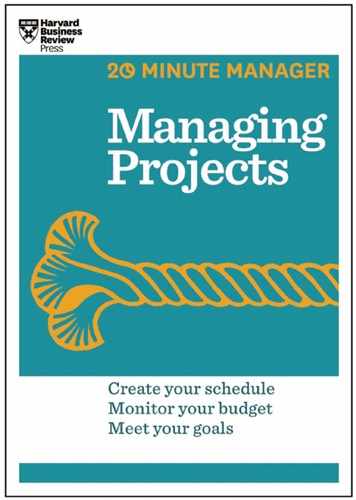Index
accountability, 5, 23, 39, 65, 69
—activities. See tasks
—attitude, 63
—authority, 5
bar charts, 51, 54–55, 57. See also Gantt charts
bottlenecks, 63, 68. See also troubleshooting
—anticipating, 48
—schedule adjustment for, 79
—ballpark, 9
—cost categories in, 58–59
—expenditure tracking and, 60
—flexibility in, 58
—progress monitoring against, 66, 69–71, 79, 80
—trade-offs in, 24–26
—Work Breakdown Structure in estimating, 26
—activities, skills, and tools for, 8
—budget development in, 56, 58–60
—steps in, 37
—team, assembling in, 37, 38–43
buy-in
—stakeholder, 18–20
—team member, 43
capital expenditures, budget for, 59
charts, 51, 52–55, 57. See also bar charts; flow charts; Gantt charts; PERT charts
—final report in, 94–99
—handoff preparation in, 92–93
—post-project evaluation in, 93–94
—self-assessment in, 100–101
—thanking team in, 100
communication
—final report, 94–99
—people issues and, 82
—of purpose of project, 44
—with stakeholders, 22–23, 26, 48, 73–74
completion dates, 9, 46. See also schedules
contingency planning, 57, 70–71
costing methods, 70
Critical Path Method, 48–51
delays, 78–79, 80. See also bottlenecks; schedules
delegation, 40–41
—kinds of tasks for, 65
—for skill development, 45
—tracking results and, 64–66
deliverables, 46, 48, 72, 77–78
drop-dead dates, 46. See also schedules
evaluation
—facilitators in, 94
—of learning, 93–94
—of underlying problem, criteria for, 15
—post-project, 93–99
—self-assessment, 100–101
—unrealistic stakeholder, 19–20
feature creep, 77–78
financial skills, 5–6
—in budgets, 58
—delegation and, 64–65
—in schedules, 47
flow charts, 51, 54–55, 57. See also PERT charts
focus
—in problem definition, 15
—in progress tracking, 67–68
Gantt charts, 51, 52, 57. See also bar charts
goals, 7
—clarifying, 16–17
—SMART, 21–22
—of stakeholders, 15
—team member involvement in, 43
—unrealistic stakeholder, 19–20
handoff preparation, 92–93
implementation phase, 3, 7, 63, 64–65
incentives, 81
learning, evaluation of, 93–94
—flexibility in, 47
—quality, 72
monitoring. See progress tracking
objectives. See goals; scope
organizational skills, 5–6, 22
overhead, budget for, 59
—access to appropriate, 22
PERT (Performance Evaluation and Review Technique) charts, 51, 53–54, 57. See also flow charts
phaseout. See closeout phase
—problem definition in, 13, 14–17
—for quality benchmarks, 72
—spelling out tasks in, 13, 26–33
—stakeholder definition in, 6, 13, 15, 18–20
—steps in, 13
post-project evaluation reports, 93–99
problems. See troubleshooting
progress tracking
—against budgets, 69–71
—budget tracking and, 59
—delegation and, 64–66
—focus in, 67–68
—against schedules, 66–69
—schedule updates and, 48
—stakeholder reporting in, 73–74
—timely information in, 68–69
—trust and track in, 66
—Work Breakdown Structure and, 31
project management, 63–74. See also projects
—budget monitoring in, 69–71
—delegating and tracking results in, 64–66
—post-project assessment of, 94–101
—progress monitoring in, 66–71
—quality assurance in, 71–72
—self-assessment on, 100–101
—skills for, 5–6
—stakeholder progress reports in, 73–74
—timely information in, 68–69
—trust and track in, 66
—what’s involved in, 4–6
projects
—what constitutes, 3–4
quality, 71–72
—goals on, 22
—poor, team problems and, 85
—trade-offs in, 25
research, budget for, 59
resources, 45, 66. See also budgets; personnel
—padding estimates and, 33
—post-project assessment of, 95
—choosing systems for, 54–55
—completion date, 9
—Critical Path Method for, 48–51
—detail level in, 47
—drop-dead dates in, 46
—estimating duration of tasks for, 32–33
—Gantt charts/PERT charts for, 51, 52–54
—progress tracking against, 66–69
—quality assurance and, 72
—sequence of activities in, 32
—tips for, 47
—trade-offs in, 24–26
—updating/revising, 48
—creep, 77–78
—in Work Breakdown Structure, 26
self-assessment, 100–101
—assembling teams with, 38–39
—delegation based on, 65
—developing through delegation, 45
—for each phase, 8
—for project management, 5–6
—task assignment based on, 42–43
—teams lacking, 83
SMART (specific, measurable, action-oriented, realistic, time-limited) goals, 21–22
software
—project-management, 57, 66–67
space, budget for, 59
stakeholders, 6
—budget overruns and, 80–81
—buy-in from, 18–20
—changes in during projects, 19
—communicating with, 22–23, 26, 48
—progress reports for, 73–74
—trade-offs and, 24–26
—unrealistic expectations of, 19–20
supplies, budget for, 59
—assigning people to, 42–43
—delegating, 65
—estimating duration of, 32–33
—scheduling, 47
—Work Breakdown Structure and, 26–33
teams
—authority over members of, 5
—challenges in leading, 40–41
—conflict within, 84
—cross-functional, 39
—delays and, 79
—departure of members from, 83
—getting the best people for, 38–39
—kickoff meetings for, 43
—motivating, 63
—overly friendly, 84
—productivity problems in, 85
—recognizing accomplishments of, 91, 100
—skills lacking within, 83
—spirit of learning in, 93–94
—structure problems with, 83
—task assignments in, 42–43
—time mismanagement by, 85
—tips for working with, 44, 45
time management, 85. See also schedules
—budget overruns and, 79–82
—delays and, 81
—scope creep and, 77–78
travel, budget for, 58
—budget overruns, 79–82
—progress monitoring and, 68–69
—scope creep, 77–78
trust and track, 66
Work Breakdown Structures (WBS), 26–33
—delegating to teams based on, 40–41
—levels in, 32
—sample of, 27–30
